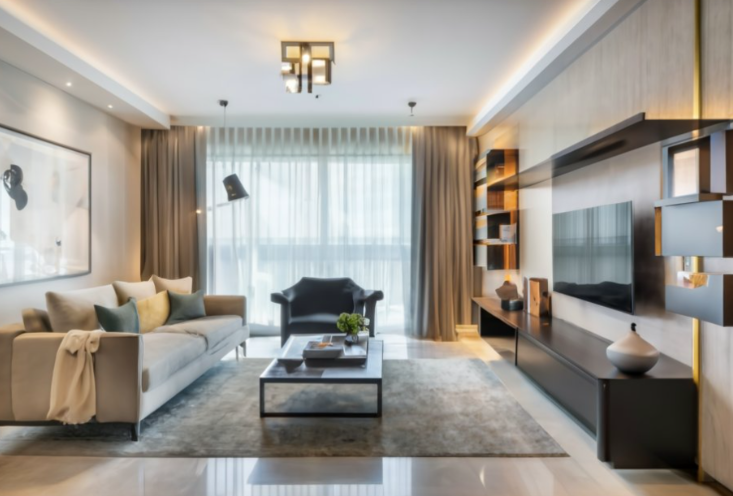Living Room Interior Design: Creating a Stylish and Functional Oasis in Your Singapore Home
The living room – the heart of your Singapore home. It’s a space for relaxation, entertainment, and gathering with loved ones. But a well-designed living room goes beyond just functionality; it sets the tone for your entire home and reflects your personal style. This guide delves into the world of living room interior design in Singapore, offering insights, tips, and inspiration to help you create a space you’ll love.
The Significance of Living Room Design
Living room design goes beyond creating a visually appealing space. It plays a crucial role in:
- Overall Aesthetics: The design sets the tone for your home, influencing the first impression visitors receive and shaping the overall ambiance.
- Functionality and Comfort: A well-designed living room caters to your needs. The layout, furniture arrangement, and lighting should facilitate activities like relaxing, watching TV, or entertaining guests comfortably.
- Personal Expression: Your living room is a reflection of your personality and preferences. The design choices you make, from furniture styles to decorative elements, tell a story about who you are.
Key Considerations for Living Room Design
Before diving into specific styles, let’s explore the fundamental aspects to consider:
A. Space Planning and Layout:
- Measure and Analyze: Accurately measure your living room and consider the placement of doors, windows, and electrical outlets. This helps optimize space and plan furniture arrangements effectively.
- Traffic Flow: Ensure smooth movement within the room. Furniture shouldn’t create bottlenecks or obstruct entryways.
- Define Areas: If space allows, consider designating specific areas within the living room, such as a conversation area, a reading nook, or an entertainment zone.
B. Color Scheme and Lighting:
- Color Psychology: Colors evoke emotions. Choose a color scheme that complements your chosen style and creates the desired mood – calming for relaxation or vibrant for an energizing atmosphere.
- Lighting Layers: Incorporate various lighting sources like overhead lighting, task lighting for specific areas (reading lamps), and accent lighting to create a layered and functional lighting scheme.
- Natural Light: Maximize the use of natural light whenever possible. Strategically place furniture to avoid blocking windows and embrace the benefits of natural light for a brighter and more inviting space.
C. Furniture Selection and Arrangement:
- Scale and Proportion: Choose furniture that is proportional to the size of your living room. Oversized furniture can overwhelm a small space.
- Functionality: Select furniture that meets your needs. Consider ottomans with storage compartments, coffee tables with shelves, or multifunctional furniture pieces that serve multiple purposes.
- Arrangement: Create a conversation-friendly layout. Arrange furniture to encourage interaction and ensure everyone feels included. Leave ample space for walking paths.
D. Décor and Accessories:
- Cohesive Theme: Choose décor and accessories that complement your overall design style. A few well-chosen pieces can elevate the space without creating clutter.
- Personalized Touches: Incorporate elements that reflect your personality and interests. This can include artwork, travel souvenirs, family photos, or conversation starters.
- Texture and Pattern: Introduce different textures and patterns through rugs, throws, cushions, or artwork to add visual interest and depth to your space.
Popular Living Room Design Styles in Singapore
Singapore’s vibrant culture is reflected in its diverse interior design trends. Here are some popular styles to consider:
A. Modern and Minimalist:
- Clean lines, uncluttered surfaces, and neutral color palettes create a sleek and sophisticated look.
- Emphasis on functionality and maximizing space.
- Ideal for small living rooms as the minimalist approach promotes a sense of spaciousness.
B. Scandinavian:
- Characterized by light, airy spaces, natural materials like wood and light fabrics, and functionality.
- Often incorporates pops of color and clean lines.
- Creates a sense of calm and comfort, perfect for creating a relaxing haven.
C. Industrial:
- Embraces raw and unfinished elements like exposed brick walls, metal accents, and concrete floors.
- Ideal for open-plan living areas for a more spacious feel.
- Creates a unique and edgy aesthetic.
D. Bohemian:
- Celebrates a free-spirited and eclectic style.
- Incorporates a mix of patterns, textures, and colors, often with a focus on handcrafted and vintage elements.
- Creates a warm and inviting atmosphere perfect for those who love to express their individuality.
Adding a Touch of Singapore
While incorporating popular styles, consider adding a touch of Singaporean flair to your living room:
A. Cultural Influences:
- Batik prints, Peranakan tiles, or traditional Singaporean motifs can add a touch of local heritage to your décor.
- Consider incorporating furniture pieces or decorative elements inspired by Singapore’s multicultural background.
B. The Beauty of Natural Materials:
- Singapore’s lush greenery can be reflected in your design. Opt for natural materials like rattan, wicker, bamboo, and wood to create a warm and organic feel.
- Plants not only add a touch of nature but also purify the air and enhance the overall ambiance.
C. Sustainable Design Practices:
- Singapore is a leader in sustainable living. Consider incorporating eco-friendly elements like energy-efficient lighting fixtures, recycled furniture, or locally sourced materials.
- Sustainable design practices not only benefit the environment but can also create a healthier living space for you and your family.
Tips for Designing a Stylish Living Room in Singapore
A. Maximizing Small Spaces:
- Smart Furniture Solutions: Opt for multifunctional furniture like ottomans with storage or sofa beds to maximize space utilization in compact living rooms.
- Mirrors and Light Colors: Strategically placed mirrors and light color palettes can create an illusion of spaciousness.
- Vertical Storage: Utilize vertical space with wall-mounted shelves, cabinets, or hanging storage solutions.
B. Balancing Functionality and Aesthetics:
- Prioritize Needs: Identify your primary needs for the living room. Do you need a dedicated entertainment area, a comfortable space for relaxation, or a multi-functional space for various activities?
- Form Follows Function: Choose furniture and design elements that not only look good but also serve a purpose.
- Edit ruthlessly: Avoid clutter. Declutter regularly and ensure decorative elements enhance, not overwhelm, the space.
C. Adding Personalized Touches:
- Artwork and Family Photos: Display artwork, photographs, or travel souvenirs that reflect your personality and interests.
- Mementos and Conversation Starters: Incorporate unique pieces that spark conversation and create a sense of warmth and personal connection.
- DIY Projects: Consider incorporating DIY projects like hand-painted cushions, a statement wall mural, or a custom coffee table to add a personal touch.
D. Embracing Natural Light:
- Singapore’s tropical climate offers abundant natural light. Make the most of it by keeping windows clear and avoiding heavy curtains that block sunlight.
- Light and Sheer Curtains: Opt for light and sheer curtains that allow natural light to filter through while still providing privacy.
- Strategic Furniture Placement: Arrange furniture to avoid obstructing windows and maximize the benefits of natural light.
Budget-Friendly Design Ideas
Creating a stylish living room doesn’t require breaking the bank. Here are some budget-conscious tips:
A. Embrace DIY Projects:
- Upcycle old furniture pieces with a fresh coat of paint or new upholstery.
- Create your own artwork or decorative elements to add a personal touch without significant cost.
- Utilize online tutorials and readily available materials for simple DIY projects like throw pillows or decorative wall hangings.
B. Second-Hand Furniture:
- Explore second-hand stores, vintage shops, or online marketplaces to find unique and affordable furniture pieces.
- With a little TLC, you can transform second-hand finds into treasured additions to your living room.
C. Creative Use of Accessories:
- Use affordable throw pillows, rugs, or artwork to add pops of color, pattern, and texture to your space.
- Consider incorporating greenery with low-maintenance indoor plants for a touch of life without a high price tag.
- Utilize decorative items from nature like seashells, pebbles, or branches to create unique and budget-friendly centerpieces or wall hangings.
Hiring a Professional Interior Designer in Singapore
If you need help creating your dream living room, consider hiring a professional interior designer in Singapore.
A. Benefits of Working with a Professional:
- Expertise and Experience: A qualified designer can translate your vision into reality, offering expert advice on space planning, furniture selection, and creating a cohesive design scheme.
- Access to Resources: Designers have access to a wider range of furniture, materials, and décor options than you might find on your own.
- Project Management: They can manage the entire design process, saving you time and stress.
B. Finding the Right Designer:
- Research and Reviews: Research potential designers online, read reviews, and look at their portfolios to find someone whose style aligns with your vision.
- Get Quotes: Request quotes from a few different designers to compare pricing and services offered.
- Initial Consultation: Schedule an initial consultation to discuss your needs, budget, and expectations.
C. Understanding the Design Process:
- Collaboration is Key: The design process is a collaborative effort. Communicate your ideas and preferences clearly to the designer, and be open to their suggestions and expertise.
- Establish a Budget: Clearly define your budget upfront and discuss it with the designer. A professional can help you work within your budget and prioritize your needs.
- Timeline and Milestones: Agree on a realistic timeline for the project and establish clear milestones to ensure the project progresses smoothly.
Conclusion: Live in Style and Comfort
Living room design is a journey of personal expression and creating a space that reflects your lifestyle and preferences. Whether you embrace a minimalist approach, a touch of Singaporean heritage, or a vibrant and eclectic style, this guide has equipped you with the knowledge and inspiration to create a living room you’ll love.
To create a functional and beautiful living space in your Singapore home, partner with MRD. Our team of experts can help you design a living room that reflects your personal style, incorporating functional storage solutions, stylish furniture, and a cohesive color scheme. Contact us today to schedule a consultation and start transforming your living room into a space that you love.



